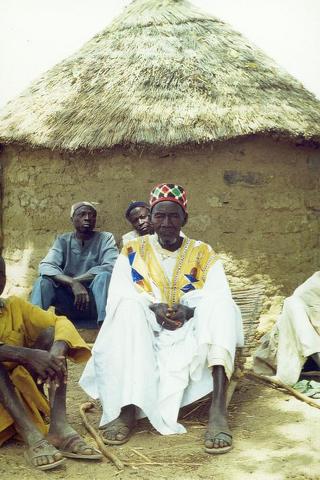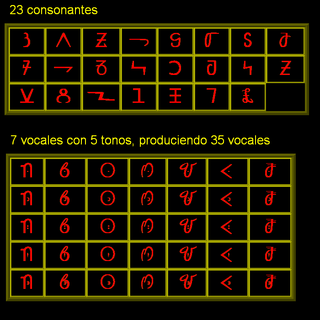Related Research Articles

Burkina Faso is a landlocked country in West Africa with an area of 274,200 km2 (105,900 sq mi), bordered by Mali to the northwest, Niger to the northeast, Benin to the southeast, Togo and Ghana to the south, and Ivory Coast to the southwest. As of 2021, the country had an estimated population of 20,321,378. Previously called Republic of Upper Volta (1958–1984), it was renamed Burkina Faso by President Thomas Sankara. Its citizens are known as Burkinabè, and its capital and largest city is Ouagadougou. Its name is often translated into English as the "Land of Honest Men".

Dyula is a language of the Mande language family spoken mainly in Burkina Faso, Ivory Coast and Mali, and also in some other countries, including Ghana, Guinea and Guinea-Bissau. It is one of the Manding languages and is most closely related to Bambara, being mutually intelligible with Bambara as well as Malinke. It is a trade language in West Africa and is spoken by millions of people, either as a first or second language. Similar to the other Mande languages, it uses tones. It may be written in the Latin, Arabic or N'Ko scripts.

Hausa ; Ajami: هَرْشٜن هَوْسَ) is a Chadic language spoken by the Hausa people in the northern parts of Nigeria, Niger, Ghana, Cameroon, Benin and Togo, and the southern parts of Niger, Chad and Sudan, with significant minorities in Ivory Coast.

The music of Burkina Faso includes the folk music of 60 different ethnic groups. The Mossi people, centrally located around the capital, Ouagadougou, account for 40% of the population while, to the south, Gurunsi, Gurma, Dagaaba and Lobi populations, speaking Gur languages closely related to the Mossi language, extend into the coastal states. In the north and east the Fulani of the Sahel preponderate, while in the south and west the Mande languages are common; Samo, Bissa, Bobo, Senufo and Marka. Burkinabé traditional music has continued to thrive and musical output remains quite diverse. Popular music is mostly in French: Burkina Faso has yet to produce a major pan-African success.

N'Ko is an alphabetic script devised by Solomana Kanté in 1949, as a modern writing system for the Manding languages of West Africa. The term N'Ko, which means I say in all Manding languages, is also used for the Manding literary standard written in the N'Ko script.

The Mossi are a Gur ethnic group native to modern Burkina Faso, primarily the Volta River basin. The Mossi are the largest ethnic group in Burkina Faso, constituting 52% of the population, or about 11.1 million people. The other 48% of Burkina Faso's population is composed of more than 60 ethnic groups, mainly the Gurunsi, Senufo, Lobi, Bobo, Bissa and Fulani. The Mossi speak the Mòoré language.

Mooré, also called More or Mossi, is a Gur language of the Oti–Volta branch and one of four official regional languages of Burkina Faso. It is the language of the Mossi people, spoken by approximately 6.46 million people in Burkina Faso, Ghana, Cote d’Ivoire, Benin, Niger, Mali, Togo and Senegal as a native language, but with many more L2 speakers. Mooré is spoken as a first or second language by over 50% of the Burkinabè population and is the main language in the capital city of Ouagadougou. It is one of the official regional languages in Burkina Faso and is closely related to Dagbani.
The Dagombas or Dagbamba are an ethnic group of Ghana, and Togo. They number more than 3.1 million people. The term Dagbamba is originally extended to refer to other related peoples who were unified by Naa Gbewaa including the Mamprusi and Nanumba. The Dagomba country is called Dagbon and they speak Dagbanli language. Dagbanli is the most spoken language of northern Ghana and second most widely spoken local language of Ghana. Dagbanli belongs to the Mabia (Mole-Dagbani) subgroup of the Gur languages, a large group of related languages in West Africa. The Dagomba practises both patrilineal and matrilineal systems of inheritance.

The Lossos are an ethnic and linguistic group of people living in the Doufelgou District (Préfecture) of the Kara Region in Northern Togo, West Africa. The district capital is Niamtougou which is also an important regional market town. The Lossos live on a plateau in the Togo Mountains between two mountain ranges: the Kabiyé Mountains to the South and the Défalé Chain to the North. They occupy the communities of Niamtougou, Koka, Baga, Ténéga, Siou, Djogrergou, Sioudouga, Kpadeba, Hago, Koukou, and Kounfaga. The Doufelgou District is bordered by the Kozah District to the South, by the Binah District to the East, by the Bassar District to the West, by the Kéran District to the North, and by the international border with Bénin to the Northeast.

Ghana is a multilingual country in which about eighty languages are spoken. Of these, English, which was inherited from the colonial era, is the official language and lingua franca. Of the languages indigenous to Ghana, Akan is the most widely spoken in the south. Dagbani is most widely spoken in the north.

Mandombe or Mandombé is a script proposed in 1978 in Mbanza-Ngungu in the Bas-Congo province of the Democratic Republic of the Congo by Wabeladio Payi, who related that it was revealed to him in a dream by Simon Kimbangu, the prophet of the Kimbanguist Church. Mandombe is based on the sacred shapes and , and intended for writing African languages such as Kikongo, as well as the four national languages of the Congo, Kikongo ya leta, Lingala, Tshiluba and Swahili, though it does not have enough vowels to write Lingala fully. It is taught in Kimbanguist church schools in Angola, the Republic of the Congo, and the Democratic Republic of the Congo. It is also promoted by the Kimbanguist Centre de l’Écriture Négro-Africaine (CENA). The Mandombe Academy at CENA is currently working on transcribing other African languages in the script. It has been classified as the third most viable indigenous script of recent indigenous west African scripts, behind only the Vai syllabary and the N'Ko alphabet.
Ajami or Ajamiyya, which comes from the Arabic root for 'foreign' or 'stranger', is an Arabic-derived script used for writing African languages, particularly those of Mandé, Hausa and Swahili, although many other African languages are written using the script, including Mooré, Pulaar, Wolof, and Yoruba. It is an adaptation of the Arabic script to write sounds not found in Standard Arabic. Rather than adding new letters, modifications usually consist of additional dots or lines added to pre-existing letters.
The Gurunsi, or Grunshi, are a set of related ethnic groups inhabiting northern Ghana and south and central Burkina Faso.

The writing systems of Africa refer to the current and historical practice of writing systems on the African continent, both indigenous and those introduced.

Bassa Vah, also known as simply Vah is an alphabetic script for writing the Bassa language of Liberia. As an old system nearing extinction in the 1900s, it was rediscovered among Bassa in Brazil and the West Indies, then revived in Liberia, by Thomas Flo Lewis. Type was cast for it, and an association for its promotion was formed in Liberia in 1959. It is not used today and has been classified as a failed script.

Burkinabé literature grew out of oral tradition, which remains important. In 1934, during French occupation, Dim-Dolobsom Ouedraogo published his Maximes, pensées et devinettes mossi, a record of the oral history of the Mossi people. The oral tradition continued to have an influence on Burkinabé writers in the post-independence Burkina Faso of the 1960s, such as Nazi Boni and Roger Nikiema. The 1960s saw a growth in the number of playwrights being published. Since the 1970s, literature has developed in Burkina Faso with many more writers being published.

The Bobo are a Mande ethnic group living primarily in Burkina Faso, with some living north in Mali. Bobo is also a shortened name of the second-largest city in Burkina Faso, Bobo-Dioulasso.

Kasena or Kassena is the language of the Kassena ethnic group and is a Gur language spoken in the Upper East Region of northern Ghana and in Burkina Faso.

The art of Burkina Faso is the product of a rich cultural history. In part, this is because so few people from Burkina have become Muslim or Christian. Many of the ancient artistic traditions for which Africa is so well known have been preserved in Burkina Faso because so many people continue to honor the ancestral spirits, and the spirits of nature. In great part they honor the spirits through the use of masks and carved figures. Many of the countries to the north of Burkina Faso had become predominantly Muslim, while many of the countries to the south of Burkina Faso are heavily Christian. In contrast many of the people of Burkina Faso continue to offer prayers and sacrifices to the spirits of nature and to the spirits of their ancestors. The result is that they continue to use the sorts of art that we see in museums in Europe and America.
The Adlam script is a script used to write Fulani. The name Adlam is an acronym derived from the first four letters of the alphabet, standing for Alkule Dandayɗe Leñol Mulugol, which means "the alphabet that protects the peoples from vanishing". It is one of many indigenous scripts developed for specific languages in West Africa.
References
- 1 2 Brookes, Tim (23 August 2022). "The Vanderbilt–Burkina Faso Connection". Endangered Alphabets. Retrieved 2023-03-26.
- 1 2 Brookes, Tim (November 2022). "Minority Languages in West Africa". MultiLingual. Retrieved 2023-03-26.
- 1 2 Simon Ager, ed. (2023). "Goulsse alphabet". omniglot.com.
- ↑ Unseth, Peter (2011). "Invention of Scripts in West Africa for Ethnic Revitalization". In Fishman, Joshua A.; García, Ofelia (eds.). Handbook of Language and Ethnic Identity: The Success-Failure Continuum in Language and Ethnic Identity Efforts. Vol. 2. New York: Oxford University Press. pp. 23–32. ISBN 978-0-19-983799-1.